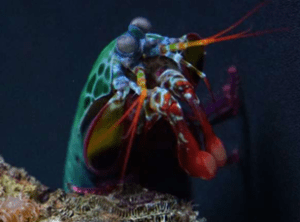Economy
Automobile Industry of India:
-
- India’s automotive industry contributes 7.1% to India’s Gross Domestic Product (GDP) and 49% to manufacturing GDP.
- India is the fourth-largest automobile producer globally.
- India’s current share in globally traded auto components is approximately 3% or 20 billion. India’s trade ratio in auto components is near-neutral (~0.99), with exports and imports nearly balancing each other.
Ecology & Environment
mantis shrimp:
-
- It is a colourful, 10-cm-long crustacean in oceans.
- They use a hammer-shaped appendage called the dactyl club to strike their prey at a blistering 23 m/s (about 50 times faster than the blink of an eye), smashing into prey’s body like a bullet from a gun fired point-blank. Strike releases enough energy to send small shockwaves through the surrounding water.
- The dactyl club of a mantis shrimp stores its energy in spring-like elastic structures held together by latch-like tendons. When latch is released, the club is released. As it moves to deliver its punch, it displaces the surrounding water and forms small low-pressure zones. Inside these zones, the water’s density drops so much that it turns into vapour, leaving behind a bubble.
- When these bubbles collapse due to the pressure of the surrounding water, they release a considerable amount of heat and shockwaves of very high frequencies, up to hundreds of megahertz.
- Thus, each dactyl-club punch delivers two blows: one from its own punch and the other from the collapsing bubbles, and together they are capable of breaking the tough shells of clams, mussels, and other crustaceans.

Important factso Scientists widely believe cyanobacteria are the first lifeforms on the earth that produced oxygen and thus filled the atmosphere with this gas during the Great Oxidation Event around 2.4-2 billion years ago. o The Ginkgo biloba tree is considered a famous example of a ‘living fossil’ a term that means the species has maintained its current form for an unusually long period of time. o Humongous fungus: Armillaria solidipes (Armillaria ostoyae) or honey mushrooms are the world’s most massive living organism, weighing up to 35,000 tonnes, and is currently growing in Oregon, USA. It may also be 8,000 years old. o Tardigrades (also known as water bears) are microscopic invertebrates known for their extreme resilience to extreme temperatures, radiation, dehydration, and even the vacuum of space. Fossil evidence suggests they have been around for approximately 500 million years. |
History, Art & Culture
Kalighat Temple:
-
- West Bengal CM inaugurated the longest skywalk in Kolkata which will connect S.P. Mukherjee Road to the famous Kalighat Temple.
- The temple is dedicated to Hindu goddess Kali, one of the 10 Mahavidyas in the Hindu tantric tradition and the supreme deity in Kalikula worship tradition.
- The temple is one of the 51 Shakti Pithas in India.
- According to mythology, on learning about death of Sati by self-immolation, Shiva was blinded in rage and started the Tandav Nritya (Dance of Destruction).
- To prevent the world from imminent destruction, Lord Vishnu used his Sudarshan Chakra to cut the corpse of Sati into 51 pieces, which fell in various places of Indian subcontinent. Kalighat is the site where toes of right foot of Dakshayani or Sati are said to have fallen.
- The present structure of temple was completed under patronage of the Sabarna Roy Choudhury family in 1809.
- Santosh Roy Chowdhury, a Kali devotee himself, started the construction of the present-day temple in 1798.
- Temple is constructed according to ath-chala style of Bengal temple architecture. Roofs of temple are gabled roofs, known as chala in Bengali, emulating thatched roofed huts made of mud and twigs in rural Bengal.
- Kalighat painting, also known as Kalighat Patachitra, emerged in 19th century. This art form was initially developed by specialized scroll painters called patuas, who worked near Kalighat Kali Temple.
Kalighat paintings:
-
- They are renowned for their bold outlines, vibrant colours, and minimal background details.
- Initially crafted on hand-made paper, artists later transitioned to machine-manufactured paper, which made production easier.
- These artworks portrayed a variety of themes, both religious and secular.
- Hindu deities, such as Kali, Shiva, Durga, and Lakshmi, were frequently depicted, as pilgrims bought these artworks as souvenirs.
- The artists also captured contemporary events and daily life in Kolkata, reflecting socio-cultural scene of the time.
- Influenced by Mughal and British art, they even painted domestic animals, fish, birds, and marine life like prawns and lobsters.
Deeksha Bhoomi:
-
- It is a central memorial built after the original Buddhist architecture, a replica of the famous stupa erected by Great Emperor Asoka at Sanchi, Madhya Pradesh. It is the biggest ever stupa in the Asian Continent.
- It was inaugurated on 18th December 2001.
- It is situated at the heart of Nagpur, Maharashtra.
- Babasaheb Ambedkar embraced Buddhism here on 14th October 1956. This is considered the only revolution where more than six million people followed at once the principles of the Dhamma.
- He studied Dhamma thoroughly and wrote book entitled ‘The Buddha and His Dhamma’ that brought out a fundamental change in religious matters.
- Babasaheb Ambedkar in his address to Buddhists stated that Nagpur was a homeland of ‘Nag’ people, the ‘Nag’ river at this place was the early settlement of those people. All the Nagaswere primarily Buddhists and in reverence to them he had chosen this place.
- He explained them in detail the ways of upliftment of life by following the Panchasilasand the Eightfold path preached by the Buddha 2550 years ago.
- Three branches of the Bodhi Tree at Anuradhapura (Sri Lanka) were requested officially to the Government of Sri Lanka and were brought to Deekshabhoomi. The saplings were taken from the same Bodhi Tree planted by Sanghamitra, daughter of the Great Emperor Asoka, during her monkhood (253 B. C.). The Bodhi Tree in Sri Lanka was originally a sapling from the bodhivrikshaunder which the Buddha became enlightened.
Note: Chaitya Bhoomi in Mumbai is a Buddhist chaitya and the cremation place of B. R. Ambedkar.
Science & Technology
AI basics: How TPU is different from CPU and GPU
-
- Google launched a new computer chip, called Ironwood. It is the company’s seventh-generation TPU, or tensor processing unit, which has been designed to run artificial intelligence (AI) models.
What are processing units?
-
- Processing units are essentially hardware units that are the brain of a computer. Like the human brain handles tasks such as reading and solving a math problem, processing units also perform tasks. These could be doing calculations, taking a picture, or sending a text.
What is a CPU?
-
- Developed in 1950s, a CPU is a general-purpose processor that can handle various tasks. It is like a conductor in an orchestra, controlling all the other components of the computer – from GPUs to disk drives and screens – to perform different tasks.
- In the initial years, CPUs used to have just one core but today, they can contain from two to up to 16 cores. As each core of the CPU can handle one task at a time, the ability to multitask is determined by the number of cores in the hardware.
What is a GPU?
-
- Unlike a CPU, a GPU is a specialised processor (it is a type of application-specific integrated circuit, or ASIC) which has been designed to perform multiple tasks concurrently rather than sequentially (like in a CPU).
- Modern GPUs comprise thousands of cores which break down complex problems into thousands or millions of separate tasks and work them out in parallel, a concept known as parallel processing. This makes GPUs far more efficient than CPUs.
- Initially developed for graphics rendering in gaming and animation, GPUs today are far more flexible and have become the bedrock of machine learning.
What is a TPU?
-
- A TPU is also a type of ASIC, meaning it is designed to perform a narrow scope of intended tasks. First used by Google in 2015, TPUs were specially built to accelerate machine learning workloads.
- TPUs have been at the heart of some of Google’s most popular AI services, including Search, YouTube and DeepMind’s large language models.
- TPUs are engineered to handle tensor — a generic name for the data structures used for machine learning — operations. They excel in processing large volumes of data and executing complex neural efficiently, enabling fast training of AI models.
- While AI models can take weeks to be trained with the help of GPUs, the same process can be executed within hours using TPUs.
GPS (Global Positioning System) spoofing:
-
- Triggering a full-borne security protocol, multiple Indian Air Force aircraft flying on different days into Myanmar, as a part of Operation Brahma, which India initiated to provide relief to the earthquake-affected nation, faced continuous GPS (Global Positioning System) spoofing.
GPS spoofing vs GPS jamming:
-
- The deliberate transmission of false GPS signals to a navigation device to alter its location is called spoofing.
- Whereas simple jamming incapacitates navigation by masking genuine satellite signals, spoofing is a far more sophisticated process, involving deliberate signal transmissions to mimic the GPS data the navigation device is supposed to follow.
- While jamming poses a problem by nullifying signals, spoofing presents a greater danger by deceiving pilots into believing they are in a different location altogether.
- When the Myanmar-headed aircraft faced “GPS interference and spoofing”, the pilots immediately switched on backup systems, called inertial navigation systems, the sources said.
PRACTICE MCQS
Q1. Consider the following statements about various Processing Units:
-
- GPU has been designed to perform multiple tasks concurrently rather than sequentially.
- GPUs are faster than CPUs due to their parallel processing.
- GPUs can replace CPU in functioning of Computer.
Which of the statements given above is/are correct?
A. 1 only
B. 1 and 2 only
C. 2 and 3 only
D. 1, 2 and 3
Answer: B
Q2. Consider the following statements about the Kalighat Temple:
-
- It is constructed according to ath-chala style of Bengal temple architecture.
- The temple is one of the 51 Shakti Pithas in India.
- Kalighat painting was initially developed by specialized scroll painters called patuas, who worked near Kalighat Kali Temple.
Which of the statements given above are correct?
A. 1 and 2 only
B. 2 and 3 only
C. 1 and 3 only
D. 1, 2 and 3
Answer: D
Q3. Consider the following statements with reference to Deeksha Bhoomi in Nagpur, Maharashtra:
-
- It is a central memorial built as replica of the famous stupa at Sanchi, Madhya Pradesh.
- It is a Buddhist chaitya and cremation place of Dr. Babasaheb Ambedkar.
- Three branches of the Bodhi Tree at Anuradhapura (Sri Lanka) were brought to Deekshabhoomi.
Which of the statements given above is/are correct?
A. 1 and 2 only
B. 2 only
C. 2 and 3 only
D. 1 and 3 only
Answer: D
Q4. Which of the following correctly describes the term ‘GPS spoofing’?
A. Deliberate transmission of false GPS signals to a navigation device to alter its location.
B. Nullifying genuine satellite signals with the help of jammers.
C. Use of regional navigational system instead of GPS.
D. Malfunctioning of GPS due to which it does not show specific location.
Answer: A
Q5. Consider the following statements:
-
- India’s automotive industry contributes about 7% to India’s Gross Domestic Product.
- India is the second-largest automobile producer globally.
Which of the statements given above is/are correct?
A. 1 only
B. 2 only
C. Both 1 and 2
D. Neither 1 nor 2
Answer: A
Download PDFSpread the Word

